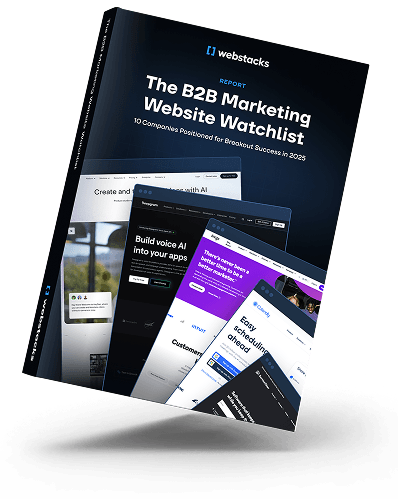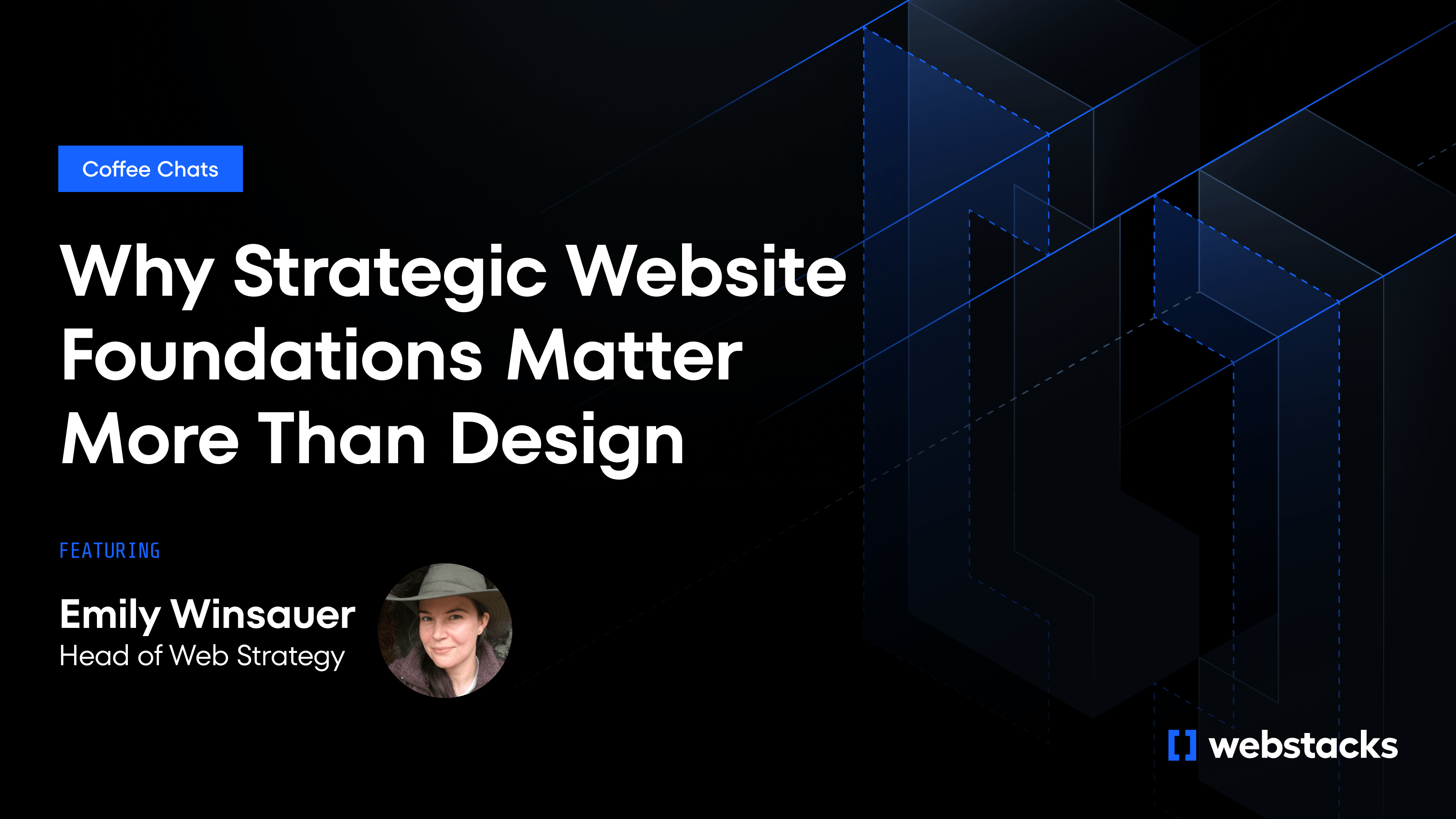Most B2B teams have some version of lead scoring. But if you dig into it, the model’s either outdated, misaligned with sales, or just sitting in the background.
The problem is that scoring is often built in a vacuum. Marketing builds it based on assumptions. Sales ignores it. And your website, which is arguably the richest source of buying signals, rarely plays a role at all. That’s a missed opportunity.
Your site captures high-intent behavior every day, such as demo requests, repeat visits to pricing, and time spent on product pages. If you’re not feeding those signals into your scoring model, you’re working with incomplete data.
Done right, B2B lead scoring shows you who’s a good fit, who’s ready to buy, what they need next, and how you can accelerate conversion.
This guide breaks down how to build a website-first lead scoring system that builds pipeline. You’ll get clear frameworks, practical examples, and a path to operationalize scoring across your CMS, CRM, and GTM team, without overcomplicating it.

What Is B2B Lead Scoring?
B2B lead scoring is the system you use to decide which leads are worth your team’s time. You assign points based on what someone does (like viewing your pricing page or signing up for a webinar) and who they are (like being a VP at a mid-market SaaS company). When a lead crosses a certain score, they get routed to sales or pushed into a campaign built for decision-stage buyers.
The real value of B2B lead scoring? Focus. With a solid scoring model, your sales team stops chasing bad-fit leads. Your campaigns stop treating every visitor the same. And your website becomes more than a digital brochure — it turns into a lead qualifier.
But here’s where most models fall short: they treat scoring like a one-time setup. Built in a spreadsheet. Never touched again. No input from sales. No connection to the site. No changes made to lead follow-up.
A working model is dynamic. It evolves as your ICP shifts, syncs with your CMS and CRM, and reacts to what visitors do on your site. When lead scoring works, everyone benefits:
- Marketing gets cleaner handoffs.
- Sales gets warmer leads.
- Buyers get a smoother experience.
If that’s not happening, it’s time to rethink how you score.
Lead Scoring Frameworks
Most B2B teams start with rule-based scoring. You assign points manually. For example, +10 for a pricing page view, +5 for attending a webinar, -10 if the lead’s a student using a personal email. It’s simple, easy to launch, and gives you full control. That’s the upside. The downside? It gets messy fast.
Rule-based models rely on guesswork. They’re hard to maintain. And once you scale (meaning more leads, more sources, and more actions), they break down. That’s when predictive scoring starts to make sense.
Predictive models use historical data and machine learning to spot patterns. They look at your closed-won deals and identify what high-converting leads have in common. Then they score future leads based on that behavior, no manual guesswork needed.
So, which one should you use?
- Startups or early-stage GTM teams: Stick with rule-based. Keep it lightweight. Test and learn.
- Growth-stage or enterprise orgs: You probably have enough data for predictive, and the need for smarter prioritization.
Regardless of the model, your website plays a key role. It’s where intent signals happen. Pageviews, form fills, CTA clicks — this is the fuel for your scoring system. Whether you’re working with rules or models, your CMS needs to track those actions and feed them back into your CRM.
How to Build a Lead Scoring Model that Actually Works
No matter what framework you follow, a lead scoring model only works if it’s built on the right inputs and aligned with how your buyers behave. Here are the fundamentals of how to build a successful lead model.
1. Audit Your Data First
Before you start assigning scores, get your data in order.
- Are your form fields standardized?
- Does your CRM capture the right info?
- Is your website tagging behavior consistent?
If your data’s messy, your scoring model will be too. Fix that first.
2. Align with Sales (Before You Touch the Model)
You can’t build a working model without input from sales. Sit down with them and ask:
- What behaviors usually signal a high-intent lead?
- What common traits do closed-won deals share?
- What are red flags or time-wasters?
Use that input to weight actions and attributes. This needs to drive actual outcomes for the team picking up the lead.
3. Configure, Test, Launch
Start small.
- Build your first version in your CRM or marketing automation platform.
- Set basic thresholds: “Score of 60 = send to sales,” for example.
- Use demo requests, pricing visits, and job titles as your core drivers.
Run a pilot. See how those leads perform. Adjust based on what closes, not what looks good in theory.
4. Iterate Quarterly
Your ICP will shift. So should your scoring. Every quarter, review:
- Are high-scoring leads converting?
- Are reps ignoring certain scores?
- Are low-scoring leads still turning into deals?
Use that feedback to tweak the model. Keep in mind that this isn’t a set-it-and-forget-it system. Treat it like a living part of your GTM motion.
Scoring Inputs that Matter
The best scoring models don’t just look at who a lead is; they also factor in what that lead does. You need both. There are three primary factors you should consider.
Fit Data (Firmographic + Demographic)
Fit data tells you who the lead is. Think job title, company size, industry, revenue, location, tech stack. It helps you qualify fit. For example:
- A Director of IT at a 500-person SaaS company? High score.
- A student using a Gmail address? Low or zero.
You can capture this data through your site forms, or enrich it using tools like Breeze (formerly Clearbit) or ZoomInfo. Just make sure the data feeds cleanly into your CRM, and that your form setup doesn’t hinder conversion.
Behavioral Data (Engagement + Intent)
Behavioral data is where your website starts doing the heavy lifting. Track actions like:
- Visiting the pricing page
- Watching a product demo video
- Returning to your site 3+ times in a week
- Downloading high-intent content (e.g. case studies or comparison guides)
Not all actions are equal. A blog post visit is not the same as a pricing page view. Score accordingly. The best teams assign higher points to actions deeper in the customer journey and trigger alerts when certain thresholds are met.
Negative Signals + Score Decay
Don’t just add points, subtract them too.
- Negative signals: If someone unsubscribes, bounces after 3 seconds, or hasn’t engaged in 90 days, drop their score.
- Score decay: Apply decay over time so old activity doesn’t carry too much weight.
This keeps your pipeline clean and focused on active opportunities, not stale leads.
How to Cultivate Website-Led Lead Scoring Opportunities
Your website isn’t just a place for people to learn about your product — it’s where most buying signals actually happen. So if you’re not connecting your scoring model to what’s happening on your site, you’re leaving money on the table. Let’s look at a few key ways you can use your site to activate lead scoring.
Dynamic CTAs
Let’s say a lead has a score of 75. Instead of showing them the standard “Learn More” button, you serve a “Book a Demo” CTA, because they’re already deep enough in the funnel to take that step.
With a modular CMS, this can happen automatically. Webstacks helps B2B teams do exactly that by structuring pages around component logic, not static templates.
Content Personalization
High-intent visitors should see content tailored to their needs. Think: case studies, product comparisons, or ROI calculators. Low-intent visitors? Provide them with guides, blog posts, and explainer videos.
This might sound complicated, but with the right CMS it’s actually easy.Just tie lead score ranges to dynamic content blocks that swap based on user data.
Smart Routing to Sales
Not every lead should wait for an SDR to reach out. Leads with high scores can trigger instant routing to a rep or drop directly into a self-booking tool like Chili Piper.That means less friction, faster follow-up, and better conversion rates.
Segmented Nurture Flows
Instead of generic email campaigns, build tracks based on score ranges. Mid-score leads get educational content. High-scorers get product deep dives and sales nudges.And since most of that behavior happens on your site, your scoring model can update in real-time based on what they’re actually engaging with.

How to Measure Success
You’ll know your lead scoring model is working when it starts driving real outcomes across marketing and sales. Here’s what to track:
- Lead-to-win rate: Are high-scoring leads closing at a higher rate than the rest? If not, revisit what you’re rewarding in the model.
- Speed to close: Are scored leads moving faster through the funnel — MQL to SQL, SQL to deal? A strong model should shorten cycle time.
- Pipeline contribution: What percentage of your pipeline is sourced from scored leads? Look at both volume and deal value.
- Marketing attribution: Can you tie real revenue back to campaigns that used lead scoring to qualify or personalize? If not, you're leaving ROI on the table.
- Sales adoption: Are reps acting on scored leads or skipping them? If scoring doesn’t match how they work, you’ll lose trust fast.
- Site signal quality: Is your CMS capturing the right behaviors, such as demo clicks, pricing visits, return sessions, and syncing them cleanly into your CRM?
- Scoring accuracy over time: Are the signals that used to indicate intent still relevant? Review closed-won data quarterly and adjust based on what’s actually converting.
How Webstacks Helps
Scoring doesn’t work if it’s disconnected from your systems. That’s where most teams get stuck — good ideas, but no infrastructure to back it up. Composable websites with a modular structure help fix that.
Modular Forms That Fuel Scoring
You need structured, reliable inputs, such as job titles, company size, and intent signals, without creating barriers to conversion. We help B2B teams build flexible form components that capture what you need and sync cleanly with your CRM.The result? Less guesswork. More usable data.
Scoring Logic Embedded in Your CMS
Want to trigger different CTAs based on lead score? Or swap content blocks based on behavior? You need a CMS that doesn’t lock you into static templates.
We build composable sites that let you tie scoring logic directly into page components, so your site responds to real buyer intent, not just generic personas.
That’s exactly what we helped Calendly do. As their growth team matured, they needed a site that could personalize at scale. We rebuilt their architecture to support modular scoring triggers and dynamic content zones, so marketing could launch, test, and iterate without touching code.
CRM + Site Integration (No Manual Handoffs)
Lead scoring should update in real-time as users engage. Our dev team connects your CMS, CRM, and scoring tools so every action on-site, such as downloads, demo views, and pricing clicks, feeds your model instantly. No delays. No sync issues. Just clean, connected data.
Iteration Without Rebuilds
Scoring models evolve. Your website should too. Our clients don’t need to wait weeks for updates. We set them up with systems that adapt as fast as their go-to-market motion. Webstacks redesigns your site to be scoring-ready from day one.
Turn Your Lead Scoring Model Into a Revenue Driver
Lead scoring model helps you create focus. It tells your team who to prioritize, when to act, and what to show next. When it works, it cuts through noise, accelerates pipeline, and aligns marketing and sales around what actually converts.
But scoring isn’t something you build once and forget. It needs to evolve with your buyers, your GTM motion, and your website. That’s where most teams fall short — and where Webstacks can help.
We help B2B companies build scoring-ready websites that not only track behavior but also respond to it. Modular forms, scoring logic baked into your CMS, real-time CRM sync, and flexible components you can actually use. No bottlenecks. No guesswork.
If you’re serious about turning your website into a revenue engine, you need more than lead capture. You need a system that qualifies, adapts, and scales. Let’s build that together.




